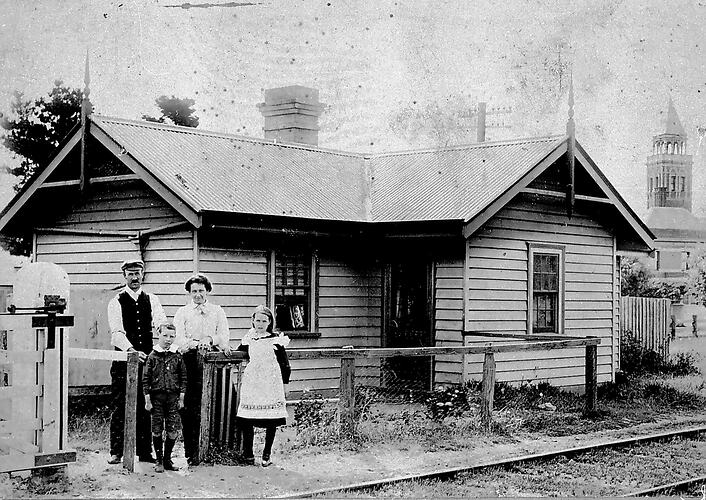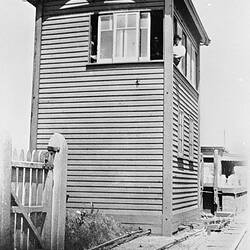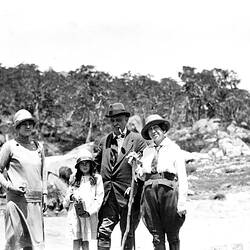Summary
Gatekeeper Rod McLean, with his family, standing beside a railway level crossing with wooden gates.
The photograph was taken in what appears to be Mentone, a bayside suburb in Melbourne's south-east, which first developed in the 1880s as a beach resort. The location is possibly the Warrigal Road crossing, where it intersects the Caulfield to Frankston Railway midway between Mentone and Parkdale Stations. This location was situated towards the end of the initial 10¼-mile (16.5 km) Caulfield to Mordialloc section of the Frankston Railway, which officially opened to traffic on Monday 19th December, 1881. Built by contractors Messrs Falkingham & Bunn, for the government-owned Victorian Railways, the route was initially completed as a single-track broad gauge (5 ft. 3 in.) line. Construction presented few engineering challenges, with a relatively flat ruling grade and only one medium-sized creek crossing. The work was supervised for the contractors by the engineer Arthur T. Robb, who subsequently become a major contractor in his own right, being involved in the construction of the Melbourne Sewerage Scheme during the 1890s, including the infamous No.1 Section of the Hobson's Bay Main, in which a fatal tunnel flooding occurred beneath the Yarra River.
As built, there were 22 level crossings between Caulfield and Mordialloc at which gatekeepers were employed, at a typical expense of at least £80 per annum in wages, while the cost of providing gatekeeper's cottages was around £120 apiece. As the land boom of the 1880s progressed, suburbs along the line experienced rapid growth, with the increased passenger traffic prompting the government to duplicate the line, with the second track to Mordialloc opening on Monday 10th December 1888. The section beyond Mordialloc, to Frankston, was initially competed in 1882 and subsequently duplicated in 1910.
In the background can be seen the distinctive square Italianate style colonnaded tower of the former Mentone Coffee Palace, erected in 1887 at a cost of £16,000, for the Royal Coffee Palace Company Limited, to the architectural designs of Messrs Reed, Henderson & Smart. After falling victim to the 1890s financial crash, the company was forced into liquidation in January 1895, and the building then sat unused for several years before being purchased by the Brigidine Sisters, of the Catholic Church, in 1904, to form the basis of Kilbreda College, in which capacity it is still used today.
Description of Content
Group outside a railway gatekeeper's cottage. The group comprises a man and woman with two young children - a girl about 10-12 years of age wearing a white apron over a dark dress and a younger boy wearing a dark jacket and knee length trousers with long black socks and a fancy white collar. The group are standing against a wooden post and rail fence with wire netting in front of a small weatherboard cottage with a brick chimney - probably a residence provided by the Victorian Railways as a family home. In the background is an ornate
More Information
-
Collection Names
-
Collecting Areas
-
Acquisition Information
Copied from K. W. Baum, 22 Jun 1988
-
Place & Date Depicted
Mentone, Greater Melbourne, Victoria, Australia, circa 1905
According to the contributor, the location depicted was orignially identified as being Newport, Victoria, however a post on the Williamstown Past Present and Future Facebook Page, forwarded to the museum by volunteer Tony Green (17/12/2019), suggested that this identification was incorrect and that the location is actually Mentone, Further research has concluded that the distinctive tower visible in the background appears to be the tower of Kilbreda College, on Como Parade, Mentone. -
Person Depicted
Mr Rod McLean - Victorian Railways, Mentone, Greater Melbourne, Victoria, Australia, circa 1905
According to the contributor, the people depicted in the photograph are Rod McLean (presumably employed as a gatekeeper with the Victorian Railways), and his family. -
Format
Negative, 35 mm, Black & White
-
Classification
-
Category
-
Discipline
-
Type of item
-
References
'Opening of the Railway to Mordialloc', The Argus (Melbourne), 20 Dec 1881, p.4, [Link 1] 'The New Railways', The Argus (Melbourne), 8 Oct 1881, p.13, [Link 2] 'The Leader. Justice to All', Oakleigh Leader (North Brighton), 8 Nov 1888, p.6, [Link 3] 'Royal Coffee Palace, Mentone', The Elsternwick Leader & District Record (Brighton), 27 Aug 1887, p.3, [Link 4] 1907 'MENTONE.', Brighton Southern Cross (Vic. : 1896 - 1918), 11 May, p. 4. , viewed 04 Jun 2021, [Link 5]
-
Keywords
Chimneys, Domestic Environment, Families, Fences, Houses, Railway Crossings, Railway Gates, Railway Workers, Weatherboard Houses, Front Yards


